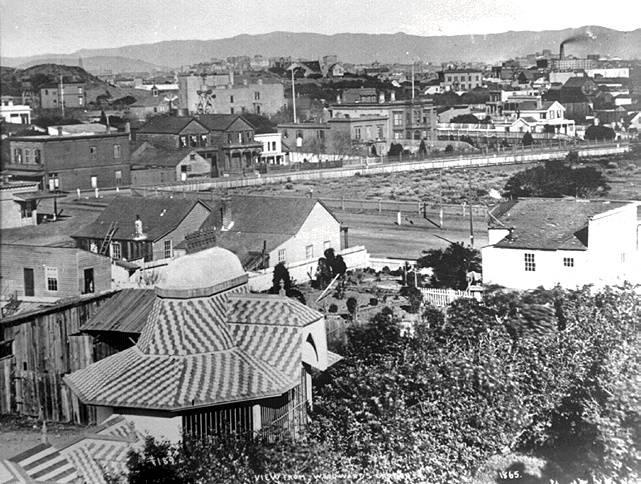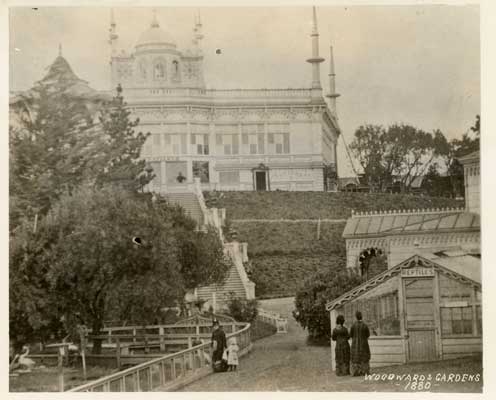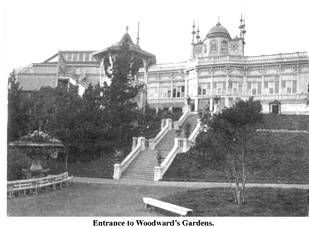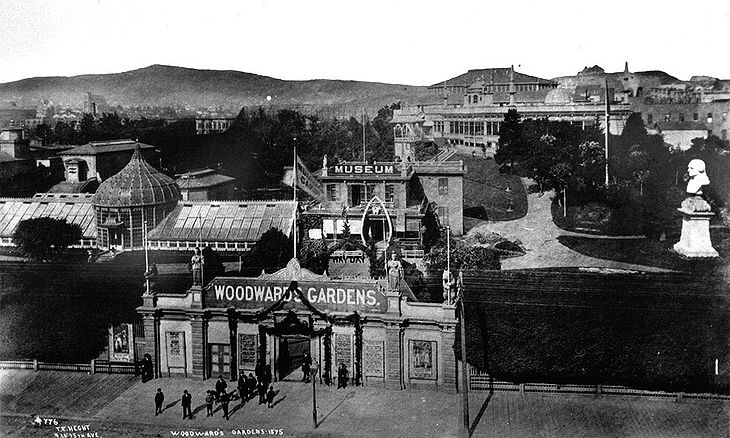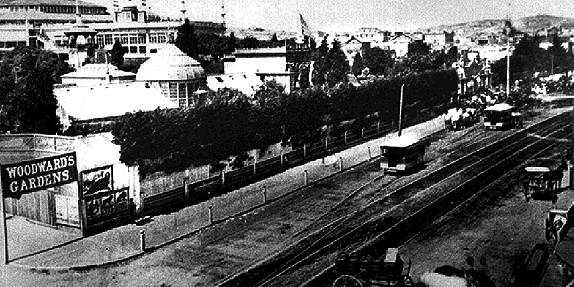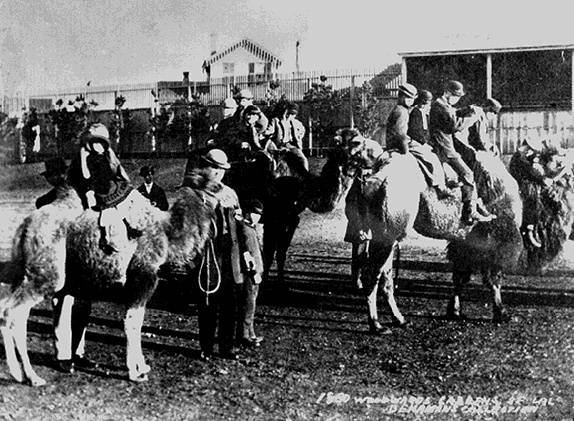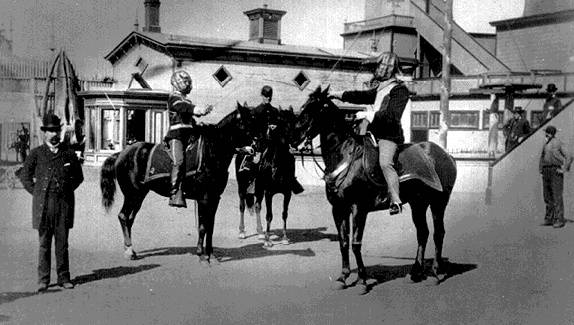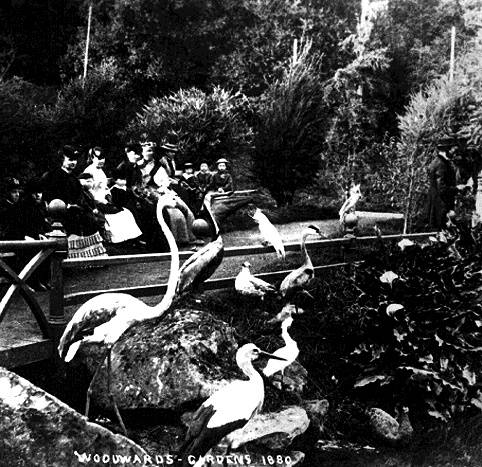Woodward's Gardens, c. 1860s: Difference between revisions
m (Protected "Woodward's Gardens, c. 1860s": finished essay [edit=sysop:move=sysop]) |
(Changed credits from Greg Garr to Private Collection) |
||
| (6 intermediate revisions by one other user not shown) | |||
| Line 8: | Line 8: | ||
'''East bay hills looking from apx. Guerrero and 14th St. Woodward's Gardens is in the foreground.''' | '''East bay hills looking from apx. Guerrero and 14th St. Woodward's Gardens is in the foreground.''' | ||
''Photo: Private Collection, San Francisco'' | |||
<div> | |||
<flashmp3>http://www.archive.org/download/TheLionsOf14thStreet/1SaroltaJaneWoodwardsGardens_vbr.mp3</flashmp3> | |||
</div> | |||
''Sarolta J. Cump's audio story about Woodward's Gardens, originally from the 2004 Audiozine "Long Ago and Right Now" '' | |||
The largest and most popular amusement grounds in the Mission, indeed in the entire city, was Woodward's Gardens which Robert B. Woodward opened''' '''at his four-acre former country estate in 1866. Woodward did not permit alcoholic beverages on the premises, but that rule did not stop San Franciscans from flocking to this botanical gardens-amusement park-museum-outdoor theater-and-zoo all rolled into one. | The largest and most popular amusement grounds in the Mission, indeed in the entire city, was Woodward's Gardens which Robert B. Woodward opened''' '''at his four-acre former country estate in 1866. Woodward did not permit alcoholic beverages on the premises, but that rule did not stop San Franciscans from flocking to this botanical gardens-amusement park-museum-outdoor theater-and-zoo all rolled into one. | ||
After paying their admission fee, the first thing that visitors saw was Woodward's former home, converted into the Museum of Natural Wonders, which held stuffed bears, birds, fish, fossils, and mineral specimens, including a ninety-seven-pound gold nugget from the Sierra Butte mine. | After paying their admission fee, the first thing that visitors saw was Woodward's former home, converted into the Museum of Natural Wonders, which held stuffed bears, birds, fish, fossils, and mineral specimens, including a ninety-seven-pound gold nugget from the Sierra Butte mine. | ||
[[Image:Reptile house, aviary, and restaurant in Woodward's Gardens 1880 AAA-7274.jpg]] | |||
'''Reptile house, aviary, and restaurant, Woodward's Gardens, 1880.''' | |||
''Photo: San Francisco History Center, San Francisco Public Library'' | |||
Next to the museum stood Woodward's Near Eastern-style conservatory, filled with exotic plants and flowers, and the art gallery, which displayed Victorian genre paintings and copies of old masters' works, plus sculpture like a copy of Hiram Powers' bust of California and a piece called ''Indian Girl at the Grave of Her Lover. ''Nearby, the rotary boat whirled around its circular track on the edge of a pond as the children on board laughed and screamed with delight. | Next to the museum stood Woodward's Near Eastern-style conservatory, filled with exotic plants and flowers, and the art gallery, which displayed Victorian genre paintings and copies of old masters' works, plus sculpture like a copy of Hiram Powers' bust of California and a piece called ''Indian Girl at the Grave of Her Lover. ''Nearby, the rotary boat whirled around its circular track on the edge of a pond as the children on board laughed and screamed with delight. | ||
| Line 37: | Line 52: | ||
A conservatory was added which housed rare and exotic trees and tropical plants, and in 1873, he opened the first public aquarium on the West Coast, which featured marine specimens from around the globe. Other additions included an amusement pavilion with pipe organ music, a lunchroom, a restaurant, and a roller rink. On weekends, live entertainment was provided, including stage plays, bands, dancers, comedians, and circus-types performing all manner of feats and spectacles. One of the main draws to the park was the zoo. Ostriches, flamingos, deer, and domestic animals were allowed to roam the gardens unhindered, while wolves, bears, lions, camels, and monkeys were kept in larger pens and cages. As with Woodward's successful hotel, alcohol was not allowed on the premises, ensuring an environment that was relatively free of rabble-rousers and unsavory characters. | A conservatory was added which housed rare and exotic trees and tropical plants, and in 1873, he opened the first public aquarium on the West Coast, which featured marine specimens from around the globe. Other additions included an amusement pavilion with pipe organ music, a lunchroom, a restaurant, and a roller rink. On weekends, live entertainment was provided, including stage plays, bands, dancers, comedians, and circus-types performing all manner of feats and spectacles. One of the main draws to the park was the zoo. Ostriches, flamingos, deer, and domestic animals were allowed to roam the gardens unhindered, while wolves, bears, lions, camels, and monkeys were kept in larger pens and cages. As with Woodward's successful hotel, alcohol was not allowed on the premises, ensuring an environment that was relatively free of rabble-rousers and unsavory characters. | ||
[[Image: | [[Image:Woodwards-Gardens-1875-by-TE-Hecht.jpg|730px|thumb]] | ||
'''The main entrance to Woodward's Gardens. N.W. cor. 14th & Mission St., 1875.''' | |||
When Mr. Woodward died in 1879, the caretakers of his estate attempted to keep the park running, but as other city attractions opened, and the resort deteriorated in appearance and popularity, the park officially closed to the public in 1891. In 1893, the land was broken up into 39 separate lots and sold. An auction was held for Woodward's extensive collections of art and curios, 75,000 articles in all were sold. Nothing remains of the once spectacular amusement resort except for photographs, ephemera, and the written reminiscences from those who saw it firsthand. A plaque commemorating the 19th century attraction hangs outside of a modern restaurant, named appropriately, "Woodward's Garden", located at 1700 Mission St. (at Duboce St.) | When Mr. Woodward died in 1879, the caretakers of his estate attempted to keep the park running, but as other city attractions opened, and the resort deteriorated in appearance and popularity, the park officially closed to the public in 1891. In 1893, the land was broken up into 39 separate lots and sold. An auction was held for Woodward's extensive collections of art and curios, 75,000 articles in all were sold. Nothing remains of the once spectacular amusement resort except for photographs, ephemera, and the written reminiscences from those who saw it firsthand. A plaque commemorating the 19th century attraction hangs outside of a modern restaurant, named appropriately, "Woodward's Garden", located at 1700 Mission St. (at Duboce St.) | ||
| Line 50: | Line 64: | ||
—Turrill, Charles B., California Notes, E. Bosqui & Co., 1876 | —Turrill, Charles B., California Notes, E. Bosqui & Co., 1876 | ||
''Photos: San Francisco History | ''Photos: San Francisco History Center, San Francisco Public Library, San Francisco, CA'' | ||
[[Scenes of Woodward's Gardens |More scenes of Woodward's Gardens]] | |||
[[Image:Mission%24woodwards%24%24woodwards-woodward4.jpg]] | [[Image:Mission%24woodwards%24%24woodwards-woodward4.jpg]] | ||
| Line 63: | Line 79: | ||
[[16th and Potrero-Seals Stadium |Prev. Document]] [[ | [[16th and Potrero-Seals Stadium |Prev. Document]] [[Scenes of Woodward's Gardens |Next Document]] | ||
[[category:Mission]] [[category:1860s]] [[category:Amusement Parks]] [[category:Encyclopedia]] | [[category:Mission]] [[category:1860s]] [[category:Amusement Parks]] [[category:Encyclopedia]] [[category:1870s]] | ||
Latest revision as of 13:55, 17 June 2014
Historical Essays
Part One by Charles Lockwood
Part Two by Christopher Craig
East bay hills looking from apx. Guerrero and 14th St. Woodward's Gardens is in the foreground.
Photo: Private Collection, San Francisco
<flashmp3>http://www.archive.org/download/TheLionsOf14thStreet/1SaroltaJaneWoodwardsGardens_vbr.mp3</flashmp3>
Sarolta J. Cump's audio story about Woodward's Gardens, originally from the 2004 Audiozine "Long Ago and Right Now"
The largest and most popular amusement grounds in the Mission, indeed in the entire city, was Woodward's Gardens which Robert B. Woodward opened at his four-acre former country estate in 1866. Woodward did not permit alcoholic beverages on the premises, but that rule did not stop San Franciscans from flocking to this botanical gardens-amusement park-museum-outdoor theater-and-zoo all rolled into one.
After paying their admission fee, the first thing that visitors saw was Woodward's former home, converted into the Museum of Natural Wonders, which held stuffed bears, birds, fish, fossils, and mineral specimens, including a ninety-seven-pound gold nugget from the Sierra Butte mine.
Reptile house, aviary, and restaurant, Woodward's Gardens, 1880.
Photo: San Francisco History Center, San Francisco Public Library
Next to the museum stood Woodward's Near Eastern-style conservatory, filled with exotic plants and flowers, and the art gallery, which displayed Victorian genre paintings and copies of old masters' works, plus sculpture like a copy of Hiram Powers' bust of California and a piece called Indian Girl at the Grave of Her Lover. Nearby, the rotary boat whirled around its circular track on the edge of a pond as the children on board laughed and screamed with delight.
Behind the pond stretched gravel paths that passed fountains, streams, small lakes, hillocks, even manmade grottos and caverns. Many of the trees and shrubs at Woodward's Gardens had been imported from Europe, and each one wore a name tag. Tame animals like ostriches, deer, and small barnyard animals wandered freely through the grounds, and nearly 100 animals filled the separate "Zoological Department" on the other side of 14th Street. Near this zoo, Woodward built an amphitheater where up to 5,000 men, women, and children watched spectacles like the Delhi fire eaters, Siberian reindeer, Japanese acrobats, dancing bears, Roman chariot races, even Major Burke and his rifle review.
--by Charles Lockwood, originally published in New Mission News
At Woodward's Gardens, poem by Robert Frost
Woodward's Gardens
by Christopher Craig
From the Virtual Museum of the City of San Francisco
Woodward Gardens was a popular public amusement resort in operation between 1865 and 1891. It was formerly located within a two square block area bounded by Mission and Valencia, and 13th and 15th Streets. Wealthy hotel proprietor Robert B. Woodward bought the property in 1861, and moved his family into the former house of General Fremont that occupied the corner of Mission and 14th Streets. Over the next five years, he invested in beautifying the residence and grounds. A new main house was completed in 1862, and ornate fountains, lakes, and manicured gardens adorned the property.
Local interest in the private estate prompted Woodward to open the grounds commercially to the general public in 1865. Locals dubbed the grounds the "Central Park of the West," and the site became very popular for picnics and events. Woodward introduced a system of horse-drawn "bob-tail cars" that brought city residents to his resort from the downtown area, utilizing the wooden plank road, which stretched along Mission Street. After relocating his family to Napa, California, the main house was converted into a museum and was filled with stuffed animals, coins, stamps, and collectables given to him by sailors and world travelers that had stayed at his well-known hotel, the What Cheer House. Later structural expansions allowed Woodward to exhibit his large collection of fine art, oil paintings, statuary, and ceramics, which he accumulated from his trips to Europe.
A conservatory was added which housed rare and exotic trees and tropical plants, and in 1873, he opened the first public aquarium on the West Coast, which featured marine specimens from around the globe. Other additions included an amusement pavilion with pipe organ music, a lunchroom, a restaurant, and a roller rink. On weekends, live entertainment was provided, including stage plays, bands, dancers, comedians, and circus-types performing all manner of feats and spectacles. One of the main draws to the park was the zoo. Ostriches, flamingos, deer, and domestic animals were allowed to roam the gardens unhindered, while wolves, bears, lions, camels, and monkeys were kept in larger pens and cages. As with Woodward's successful hotel, alcohol was not allowed on the premises, ensuring an environment that was relatively free of rabble-rousers and unsavory characters.
The main entrance to Woodward's Gardens. N.W. cor. 14th & Mission St., 1875.
When Mr. Woodward died in 1879, the caretakers of his estate attempted to keep the park running, but as other city attractions opened, and the resort deteriorated in appearance and popularity, the park officially closed to the public in 1891. In 1893, the land was broken up into 39 separate lots and sold. An auction was held for Woodward's extensive collections of art and curios, 75,000 articles in all were sold. Nothing remains of the once spectacular amusement resort except for photographs, ephemera, and the written reminiscences from those who saw it firsthand. A plaque commemorating the 19th century attraction hangs outside of a modern restaurant, named appropriately, "Woodward's Garden", located at 1700 Mission St. (at Duboce St.)
Bibliography
—Palmer, Mrs. Silas H, Vignettes of Early San Francisco Homes and Gardens: Program of the SF Garden Club, Woodward's Gardens, 1935
—Turrill, Charles B., California Notes, E. Bosqui & Co., 1876
Photos: San Francisco History Center, San Francisco Public Library, San Francisco, CA
More scenes of Woodward's Gardens
Woodwards: "Pelicans and Nature at Woodward's Gardens c. 1888"

